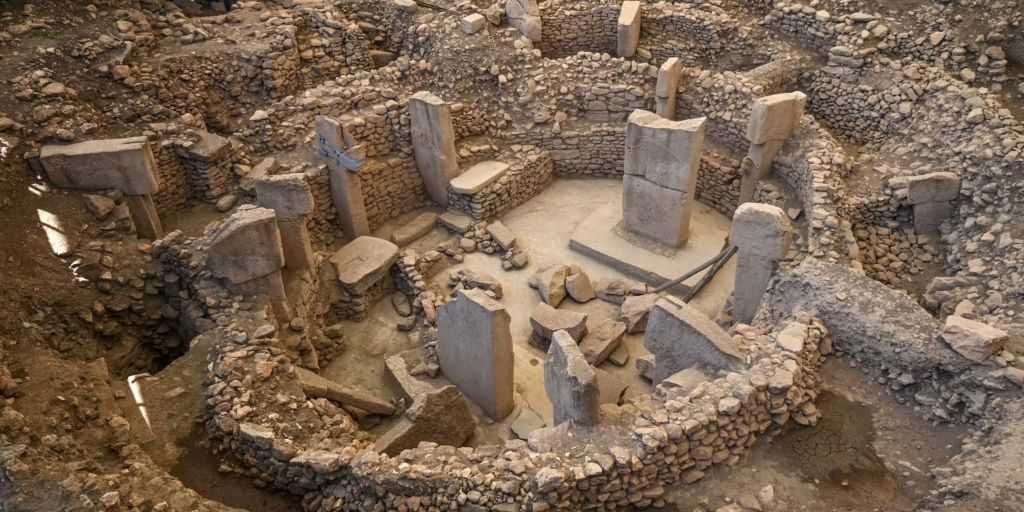Imagine a time before farming, before settled villages, before writing, and even before the wheel. What drove early humans to gather, to build, to connect with something larger than themselves? For centuries, we believed that monumental architecture and organized religion were products of settled, agricultural societies.
But then, a groundbreaking discovery in southeastern Turkey shattered that understanding, pushing back the timeline of human spiritual ambition by thousands of years. It forced us to rethink everything we thought we knew about the dawn of civilization.
So, when you ask, “Which is the world’s oldest temple?” – prepare to be amazed.
The Unveiling: Göbekli Tepe, The True Oldest Temple
The undisputed title of the world’s oldest known temple belongs to Göbekli Tepe, located in modern-day southeastern Turkey, near the city of Şanlıurfa.
This extraordinary archaeological site is estimated to be over 11,500 years old, dating back to the Pre-Pottery Neolithic A period (around 9600–8200 BCE). To put that into perspective, it predates:
- The invention of writing by over 6,000 years.
- The widespread adoption of agriculture.
- The first known use of the wheel.
- Even Stonehenge by a staggering 6,000 years!
Why Göbekli Tepe is So Revolutionary
Discovered in the 1960s but with major excavations beginning in 1994 under German archaeologist Klaus Schmidt, Göbekli Tepe consists of massive, intricately carved stone pillars arranged in circular enclosures. Some of these T-shaped pillars weigh as much as 50 tons and stand over 18 feet tall.
What makes this site truly revolutionary is that it was built by hunter-gatherers. This completely upended the prevailing theory that complex societies, organized religion, and monumental architecture only arose after humans settled down and began farming. Göbekli Tepe suggests that the communal effort required to build such a sophisticated ritual site might have actually preceded and even driven the shift towards settled life and agriculture.
The pillars are adorned with stunning carvings of animals like foxes, snakes, wild boars, birds, and scorpions, as well as abstract symbols. The exact purpose of these structures is still debated, but archaeologists widely agree it served as a significant ritual or ceremonial gathering place, a spiritual hub for ancient communities.
A Glimpse at Other Ancient Wonders (and why Göbekli Tepe stands apart)
While Göbekli Tepe holds the current title, it’s worth noting other incredibly ancient and significant spiritual sites around the world:
- Stonehenge (England): This iconic stone circle began construction around 3000 BCE, making it roughly 5,000 years old. An impressive feat, but still much younger than Göbekli Tepe.
- Maltese Megalithic Temples (Malta): Sites like Ġgantija and Ħaġar Qim are among the oldest free-standing stone structures in the world, dating back to around 3600-3000 BCE (around 5,600-5,000 years old).
- The Ziggurat of Ur (Iraq): This massive stepped pyramid, a temple complex dedicated to the moon god Nanna, dates back to around 2100 BCE (about 4,100 years old) in ancient Mesopotamia.
These sites are undeniably ancient and awe-inspiring, showcasing the long human history of spiritual expression and architectural prowess. However, Göbekli Tepe’s sheer antiquity and its builders’ pre-agricultural lifestyle set it apart as a truly unique and paradigm-shifting discovery.
The Enduring Legacy
The ongoing excavations at Göbekli Tepe continue to provide invaluable insights into the minds and societies of our earliest ancestors. It challenges us to reconsider how and why human civilization emerged, highlighting the profound role that shared belief systems and ritual might have played in shaping our collective destiny.
It’s a testament to the enduring human quest for meaning, connection, and a deeper understanding of the universe, proving that even in the distant past, our ancestors looked to the heavens and built monuments to their beliefs.



46dkyu
Good info. Lucky me I reach on your website by accident, I bookmarked it.
Thank you, I’ve just been looking for info approximately this topic for a while and yours is the greatest I have found out so far. However, what in regards to the conclusion? Are you sure in regards to the supply?
I am often to blogging and i really appreciate your content. The article has really peaks my interest. I am going to bookmark your site and keep checking for new information.
I am glad to be a visitor of this sodding web site! , regards for this rare information! .